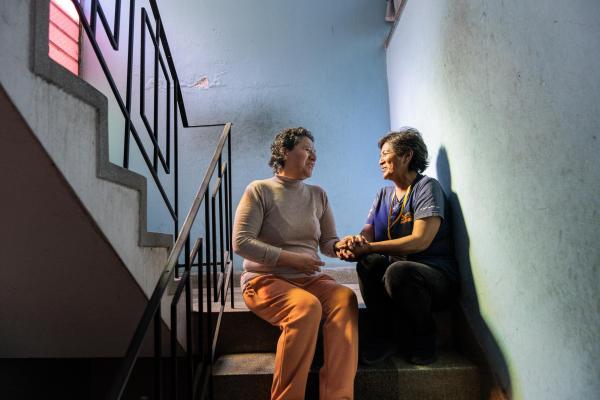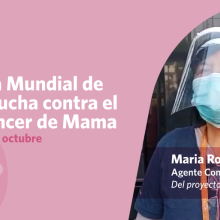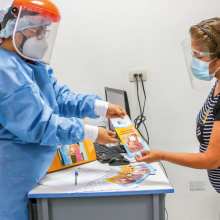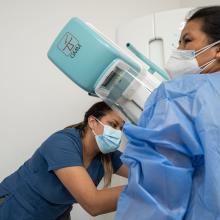In 2021, Isabel Alegre, 49, went to the Santa Luzmila II Maternal and Child Health Center, located in the district of Comas, to take advantage of a free screening campaign for breast cancer, diabetes, among other non-communicable diseases by Socios En Salud.
That year, Isabel had started to feel a slight pain in her left breast, which she associated with a blow accidentally received five years earlier. However, after undergoing a clinical checkup, she learned that it was not a muscular problem.
“The obstetrician found a lump and sent me for an ultrasound,” she recalls. It was after that exam that she was recommended to have a mammogram, arranged through Socios En Salud at the Cori Clinic, located in Los Olivos, and also a biopsy at the National Institute of Neoplastic Diseases (INEN).
The diagnosis turned out to be discouraging: she was suffering from stage II breast carcinoma. “I felt like I had been thrown a bucket of cold water,” Isabel says. “My concern was mostly about who could help me, because I don’t have the financial means (to deal with the disease).”
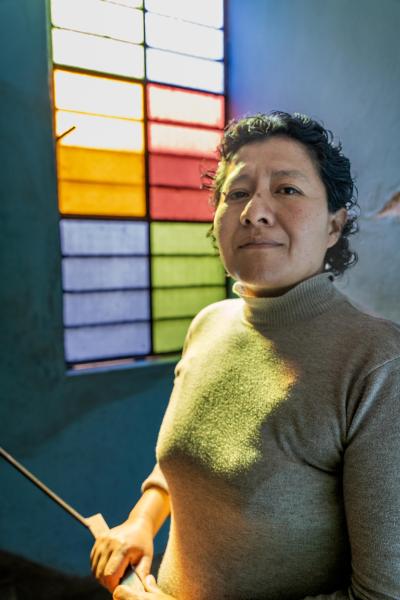
Con 51 años, Isabel Alegre continúa su tratamiento para el cáncer de mama que le fue detectado en 2021 a través de las gestiones de Socios En Salud.
Foto de Diego Diaz
A timely detection is a life saved
In Peru, breast cancer is considered the second most frequent neoplasm in the country. Last year, it affected more than 2,000 women, as reported by the Ministry of Health (MINSA). Although early diagnosis reduces the mortality rate, detection is not always done in time due to the population’s lack of knowledge or fear of the results.
Faced with this situation, the Non-Communicable Diseases and Cancer Program (better known as NCD) of Socios En Salud developed the ALMA intervention in 2020, with the aim of contributing to timely breast cancer screening in women aged 40 to 69 years in Comas and Carabayllo, two districts of northern Lima.
From then until 2023, a total of 2,843 women accessed a mammogram in the health system through the project. Of all of them, 12 obtained stage I or II cancer results; that is, their disease was detected at an early stage.
“At DIRIS Lima Norte, we did not have many resources to respond to the high demand from the population for these exams. That is why ALMA is so important for testing all these women,” stresses Dr. Milagros Montes, coordinator of the Cancer Control and Prevention Strategy of this division of MINSA.
Search and orientation, the first steps
How through Socios En Salud did the health system manage to increase the number of diagnoses? Thanks to the tireless work of a network of community health agents trained in recruiting and sensitizing people for breast cancer screening.
“We went to the markets, house to house, looking for patients,” says community health worker Zoila Mantilla. “Most of the moms think that going for a clinical exam and having an ultrasound is enough. That’s why we guide them.”
She, along with agent María Rosas, traveled the Comas district inch by inch not only to promote diagnosis, but also to educate about detection. Two key steps, according to the MINSA representative, in the fight against breast cancer.
“The population already knows what a mammogram is, they have absolved their doubts. That is the first step for a subsequent diagnosis,” she says.
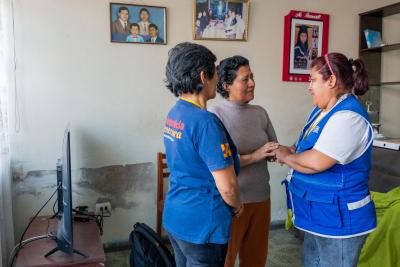
La agente comunitaria María Rosas (de espalda), junto con su colega Zoila Mantilla (quien sostiene las manos de Isabel Alegre) realizaron un trabajo fundamental en Comas durante la búsqueda activa de pacientes con cáncer de mama.
Foto de Diego Diaz
To accompany is to be healthier
Isabel Alegre still remembers how disoriented she was when she was diagnosed with breast cancer. She didn’t know where to go, how to make an appointment, what process she should follow in the intricate health care system to treat her disease.
“If I had come alone, I wouldn’t have known what to do,” she says.
However, after being recruited by the ALMA project, Isabel was accompanied by Maria Rosas. It was through her that she was able to mobilize to INEN, make her appointments, attend her therapies and receive psychological support in the Mutual Support Group she joined.
“I value very much the accompaniment, the counseling that (Maria) gave me,” she says. “I felt calmer, because Maria had the experience.”
It is the accompaniment the main lesson that this ENT Program project has bequeathed to MINSA, according to the coordinator of DIRIS Lima Norte. She affirms that today the division she is in charge of has “institutionalized” this process.
“It is important to accompany women in all these processes so that they do not get lost along the way and in the problems of the health system itself, which, as we know, has its delays. ALMA has allowed us to take actions and decisions in this implementation process until we made it our own,” she says.
Today, Isabel has undergone surgery and has already completed her chemotherapy. She is still taking pills, but despite the ravages of the disease, she feels like she is in company. She feels healthier.
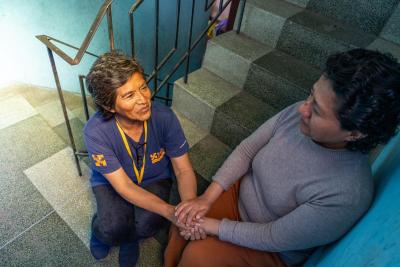
Con el acompañamiento de la agente comunitaria María Rosas, Isabel Alegre pudo alcanzar la adherencia en su tratamiento de cáncer de mama.
Foto de Diego Diaz
Other improvements in the process
Following the intervention by Socios En Salud, MINSA recognized the importance of offering a mammography service to a population that was then underserved. “Lima Norte has more than 3 million inhabitants, where 25% are women between 40 and 69 years of age,” Dr. Montes specifies.
Currently, the DIRIS Lima Norte is the only one that has two health facilities with a mammograph at its primary level of care. “Added to this is the follow-up,” the coordinator points out. “We have shortened the timeframes in accompanying women and speeding up some processes.”
One example speaks for itself: if in the past an appointment for a mammogram could take between three to four months, today it has been reduced to two weeks from the recruitment of the potential patient to the performance of the exam. “Times have been reduced considerably with the project,” Montes emphasizes.
